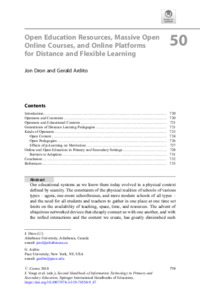Open Education Resources, Massive Open Online Courses, and Online Platforms for Distance and Flexible LearningJon Dron, Gerald Ardito
Zu finden in: Second Handbook of Information Technology in Primary and Secondary Education (Seite 719 bis 735), 2018
  |
 |
 Diese Seite wurde seit 1 Jahr inhaltlich nicht mehr aktualisiert.
Unter Umständen ist sie nicht mehr aktuell.
Diese Seite wurde seit 1 Jahr inhaltlich nicht mehr aktualisiert.
Unter Umständen ist sie nicht mehr aktuell.
 Zusammenfassungen
Zusammenfassungen
 Our educational systems as we know them today evolved in a physical context defined by scarcity. The constraints of the physical realities of schools of various types – agora, one-room schoolhouses, and more modern schools of all types – and the need for all students and teachers to gather in one place at one time set limits on the availability of teaching, space, time, and resources. The advent of ubiquitous networked devices that cheaply connect us with one another, and with the reified interactions and the content we create, has greatly diminished such constraints, as have new pedagogies more suited to these open and connected learning environments. We are only beginning to adapt our educational systems to fit this new, less rivalrous, less bounded, more open reality. This chapter describes some of the main features of this more open universe, explores the different kinds of openness that are enabled, and describes some of their consequences for primary and secondary educators and learners.
Our educational systems as we know them today evolved in a physical context defined by scarcity. The constraints of the physical realities of schools of various types – agora, one-room schoolhouses, and more modern schools of all types – and the need for all students and teachers to gather in one place at one time set limits on the availability of teaching, space, time, and resources. The advent of ubiquitous networked devices that cheaply connect us with one another, and with the reified interactions and the content we create, has greatly diminished such constraints, as have new pedagogies more suited to these open and connected learning environments. We are only beginning to adapt our educational systems to fit this new, less rivalrous, less bounded, more open reality. This chapter describes some of the main features of this more open universe, explores the different kinds of openness that are enabled, and describes some of their consequences for primary and secondary educators and learners. Dieses Kapitel erwähnt ...
Dieses Kapitel erwähnt ...
 Personen KB IB clear | T. J. Bliss , Karen Brennan , Evelyn Eastmond , Idit Harel , David H. Jonassen , Yasmin B. Kafai , John Maloney , Sylvia Libow Martinez , Mary McEwen , Amon Millner , Andrés Monroy-Hernández , Seymour Papert , Mitchel Resnick , Eric Rosenbaum , Natalie Rusk , George Siemens , Jay Silver , Brian Silverman , Gary Stager , David A. Wiley | ||||||||||||||||||||||||||||||||||||||||||||||||||||||
 Begriffe KB IB clear |  Edmodo
, Google Classroom
, MOOCMassive Open Online Course
, Edmodo
, Google Classroom
, MOOCMassive Open Online Course
,  Moodle
, Moodle
,  Offenheit Offenheit openness
, openness
,  Open Educational Resources (OER) Open Educational Resources (OER) Open Educational Resources Open Educational Resources
| ||||||||||||||||||||||||||||||||||||||||||||||||||||||
 Bücher |
| ||||||||||||||||||||||||||||||||||||||||||||||||||||||
 Texte |
|
 Zitationsgraph
Zitationsgraph
 Zitationsgraph (Beta-Test mit vis.js)
Zitationsgraph (Beta-Test mit vis.js)
 Anderswo finden
Anderswo finden
 Volltext dieses Dokuments
Volltext dieses Dokuments
 |  Open Education Resources, Massive Open Online Courses, and Online Platforms for Distance and Flexible Learning: Artikel als Volltext bei Springerlink ( Open Education Resources, Massive Open Online Courses, and Online Platforms for Distance and Flexible Learning: Artikel als Volltext bei Springerlink ( : :  , 262 kByte; , 262 kByte;  : :  ) ) |
 Anderswo suchen
Anderswo suchen 
 Beat und dieses Kapitel
Beat und dieses Kapitel
Beat hat Dieses Kapitel während seiner Zeit am Institut für Medien und Schule (IMS) ins Biblionetz aufgenommen. Beat besitzt kein physisches, aber ein digitales Exemplar. Eine digitale Version ist auf dem Internet verfügbar (s.o.). Es gibt bisher nur wenige Objekte im Biblionetz, die dieses Werk zitieren.
















 Biblionetz-History
Biblionetz-History